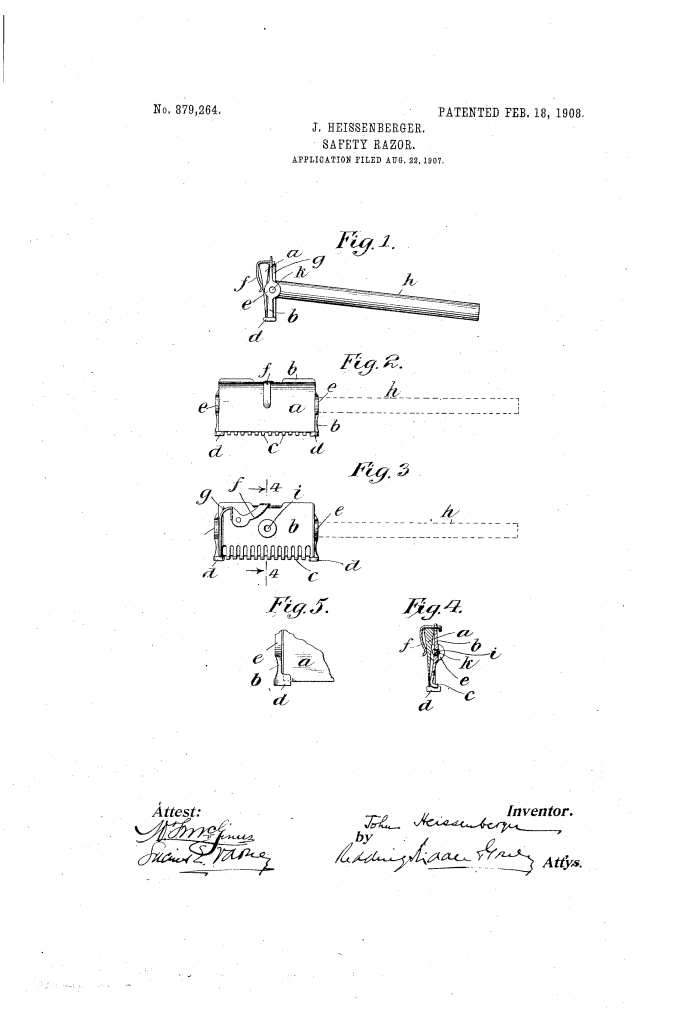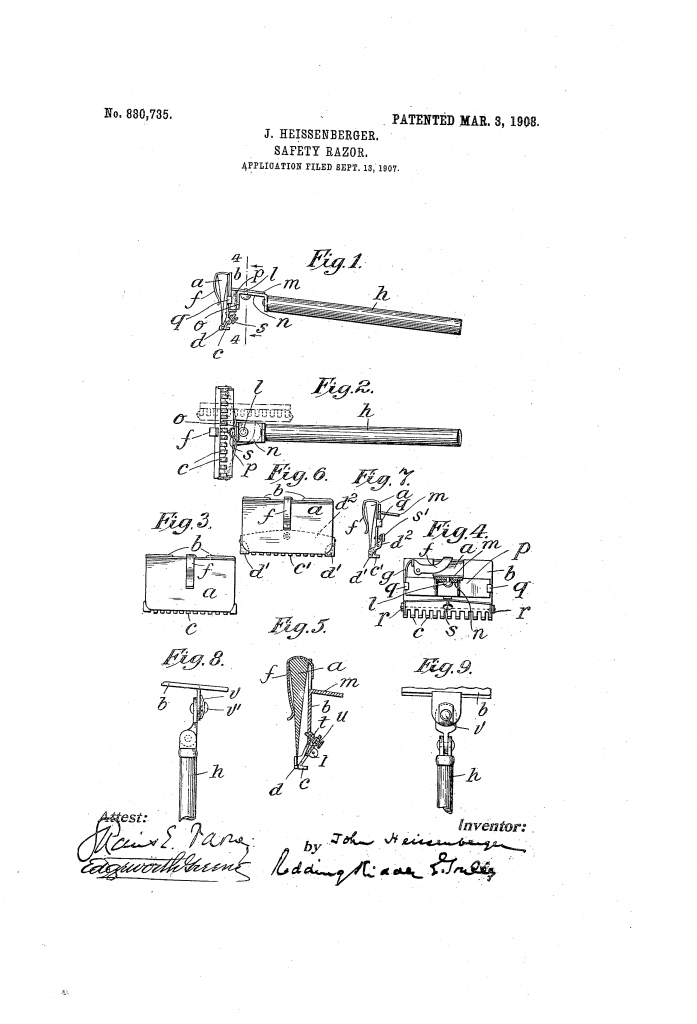John Heissenberger was a fairly prolific inventor at the turn of the last century. And in between such fun things as machines to exhibit illuminated pictures, punching machines, and mail-delivering apparatuses, he did take the time to invent a couple of wedge razors.
For those unfamiliar with the term, a wedge razor is a safety razor that uses a wedge shaped blade. Think a section of a straight razors, instead of the flat blade of most other safety razors.
There is little that was revolutionary with John’s razors. They are an interesting assembly of ideas, and well worth a closer look.
John Heissenberger took out two patents on essentially similar safety razors. The first was filed in August ’07 and granted in February ’08, while the second was filed in September ’07 and granted in March ’08. Both were registered to a company called Automatic Utilities Co., which were also the assignee of John’s other patents. Automatic Utilities Co. used “All-Ways” as a trademark, and is mentioned in Waits’ Compendium.1
Both patents shares similarities beyond the wedge blade. They both used a toothed guard, and a spring loaded hook to retain the blade. They both could be used as hoe style razors, or as shavettes.2 Where they differed was in how to adjust the handle.
But first, let us see how the patent texts describe the object of each invention:
One object of this invention is to provide a safety razor in which the blade is easily attachable and detachable and while attached is retained upon the razor base or holder in a simple manner, the construction requiring very few parts and being considerable simplified.
From US patent 879,264
A great many of the safety razors now in use are provided with handles which are rig idly secured to the base or plate upon which the blade is fastened so as to be substantially perpendicular to this base or plate and to the razor blade. The blade, in such devices, is thus always held in a particular position with respect to the handle. It is convenient, however, to shave different parts of the face with the blade in different positions with respect to the handle; where for instance either side of the face is to be shaved, it is convenient to have the handle extended in the plane of the blade, and in a safety razor, where there is a guard on one side of the blade, it is desirable to be able to extend the handle in the plane of the blade with the guard upon either side.
From US patent 880,735
So on one hand, make it simple and easy to take the blade out. On the other hand, make it so the handle can be in different orientations to the blade.


Both razors seems to mostly be made of bent sheet metal pieces. So arguable they have a simplified construction. Both razors uses a spring loaded hook3 to keep the blade in place. Tensioned by a flat spring, the hook would be biased closed.
The main difference between the two patents is how the handle is attached.
In the first patent, there is simply three threaded holes to screw the handle into. One on the underside of the razor head, which let you use the razor as a classic hoe razor. The two other on the left and right, to let you use it as a shavette.
In the second patent, which made it to production, the handle is mounted on a hinge. This let the shaver place the handle anywhere in a 180° arc. A variation on this patent4 have two hinges, letting the user place the handle anywhere within a full hemisphere.
As mentioned, the razors is listed in Waits’ Compendium. Reading the description, and looking at the images, the only conclusion I can make is that the second patent actually made it to production. And while there may not be much of a market today, I can easily see both designs adapted for use with GEM blades.
The full text of both the first and second patent can be read at Google Patents.
Footnotes:
- Located at page 8 in the version 1.21.
- Even if the term shavette was not even dreamt up at the time.
- Conviniently marked as f in both drawings.
- Shown in figures 8 and 9 in the drawing for the second patent.

Pingback: The wedge razors of John Heissenberger - Razors n Blades the shave that saves
Pingback: An early face moistening razor - Wegian WetshavingWegian Wetshaving